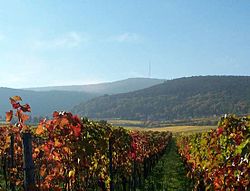Palatinate wine
| Wine region | |
 |
|
| Years of wine industry | Since 1st century AD |
|---|---|
| Country | Germany |
| Part of | Rhineland-Palatinate |
| Size of planted vineyards | 233.4 km ² |
| No. of vineyards | 350 |
| Comments | 6.5 million hl produced annually |
Palatinate (German: Pfalz) is a German wine-growing region (Weinbaugebiet) in the area of Bad Dürkheim, Neustadt an der Weinstraße, and Landau in Rhineland-Palatinate. Before 1993, it was known as Rhine Palatinate (Rheinpfalz). With 23,461 hectares (57,970 acres) under cultivation in 2008, the region is the second largest wine region in Germany after Rheinhessen. There are about 6,800 vintners producing around 6.5 million hectolitres of wine annually.
Although wild varieties of the vine were most probably native in the Palatinate region, the Romans brought the cultivated vine and winegrowing techniques around 1 A.D. Several Roman landhouses (villa rusticae) were found in the Palatinate region, for example near Wachenheim and Ungstein.
The Flurbereinigung restructuring of the 1980s raised the quality of the area's vineyards to modern standards and by the end of the 20th century, Palatinate wines were garnering international notice for their quality.
The Palatinate wine region overlaps with, but is not coextensive with, the traditional German region of Palatinate, making up only 5% of its area. The wine region is an 80-km stretch situated under the lee of the Palatinate Forest on the Haardt Mountains, a continuation of Alsace's Vosges Mountains. Its climate is much like that of Alsace (France) in the south or Baden (Germany) in the east; and it is one of the warmest, sunniest and driest of German wine regions, with only parts of Baden (the only Zone B region in Germany), such as the Kaiserstuhl, being warmer. The vineyards are planted on a mixture of sandstone and volcanic soil.
...
Wikipedia
